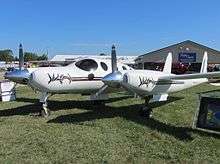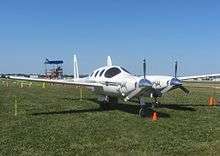Rutan Boomerang
| Boomerang | |
|---|---|
 | |
| Role | Experimental light aircraft |
| National origin | United States |
| Manufacturer | Scaled Composites |
| Designer | Burt Rutan |
| Number built | 1 |
|
| |


The Rutan Model 202 Boomerang is an aircraft designed and built by Burt Rutan. The design was intended to be a multi-engine aircraft that in the event of failure of a single engine would not become dangerously difficult to control due to asymmetric thrust. The result is an asymmetrical aircraft with a very distinct appearance.
Design and development

The Boomerang was designed around the specifications of the Beechcraft Baron 58, one of the best known and most numerous twin-engine civilian aircraft. The use of the asymmetrical design allows the Boomerang to fly faster and farther than the Baron using the same engines, and seating the same number of occupants.[1] The Boomerang is powered by two engines, with the right engine producing 10 hp (8 kW) more power than the left one (the engines are in fact the same model, just rated differently). The wings are forward-swept.[2]
In 1997, avionics entrepreneur Ray Morrow and his son, Neil Morrow, founded an air taxi company. They settled on a modified version of Rutan's Boomerang design, which they designated the MB-300. They determined that the best business approach would be to manufacture the aircraft and run the air taxi services themselves. So Ray Morrow founded Morrow Aircraft Corporation in order to design and manufacture the MB-300. In the meantime, they started the SkyTaxi company using Cessna 414s as interim aircraft.[3] In 1999, Morrow Aircraft Corporation applied to the Federal Aviation Administration (FAA) of the United States for a type certificate for the MB-300. In 2000, the FAA published a notice seeking comments on Morrow Aircraft's proposal to use an electronic engine control system (FADEC) in place of the engine's mechanical system.[4]
Rutan's Boomerang was restored to flying condition in 2011 and made an appearance at Oshkosh that year as part of the Tribute to Rutan.[5]
Specifications (Boomerang)
Data from Air&Space Magazine September 2012[2]
General characteristics
- Crew: 1 pilot
- Capacity: 4 passengers (1,000 lb payload cabin)
- Length: 30 ft 8 in (9.36 m)
- Wingspan: 36 ft 8 in (11.12 m)
- Height: ()
- Wing area: 102 ft² (9.5 m²)
- Aspect ratio: 13.2
- Empty weight: 2,359 lb (1,070 kg)
- Max. takeoff weight: 4,189 lb (1,900 kg)
- Powerplant: 1 × Lycoming TIO-360-A1B and 1x Lycoming TIO-360-C1A6D four-cylinder air-cooled piston engine, 200 + 210 hp (149 + 157 kW)
Performance
- Maximum speed: 311 mph (530 km/h, 270 kt)
- Cruise speed: 250 mph (402 km/h, 217 kt) at FL155, 47% power (best range)
- Stall speed: 80 mph (130 km/h, 70 kt)
- Range: 2,362 miles (3,780 km) 2,960 miles at 37 percent
- Rate of climb: 1,900 ft/min (579 m/min)
Avionics
2011 upgrade :
- Garmin GMA 350 audio panel
- Garmin GTN 750 touch screen WAAS GPS NAV/comm.
- Garmin GTX 327 transponder
- UAV Navigation EFIS touch screen EFIS display
- Bertucci Display custom system monitor
- AuRACLE 2120 with dual screens (engine parameters)
- iPad 2 running ForeFlight mobile HD (VFR/IFR charts, airport info and taxiway)
See also
- Blohm & Voss BV 141 - asymmetric German design of World War II
References
- ↑ Sugar, Jim (November 1, 1996). "Boomerang!". Popular Mechanics.
- 1 2 Schapiro, Steve. "Burt Rutan's Favorite Ride", Air & Space/Smithsonian, September 2012. Retrieved: 11 September 2012.
- ↑ Ross, Robert (Winter 2001). "Neil Morrow: From Snowboards to SkyTaxi". Embry-Riddle Aeronautical University. Retrieved 2006-04-01.
- ↑ Federal Aviation Administration. (May 15, 2000). "Special Conditions: Installation of Full Authority Digital Engine Control (FADEC) System on Morrow Aircraft Corporation Model MB-300 Airplane". Federal Register 65 (94): 30936–30938. Docket No. CE161; Notice No. 23-00-02-SC.
- ↑
Official Rutan Boomerang Website - January 31, 2012 Autopia - Burt Rutan’s Boomerang: Safety Through Asymmetry - July 29, 2011 EAA- As designed, Rutan's Boomerang returns to Osh - July 2011
External links
![]() Media related to Rutan Boomerang at Wikimedia Commons
Media related to Rutan Boomerang at Wikimedia Commons
| ||||||||||||||||||||||||||||||||||||